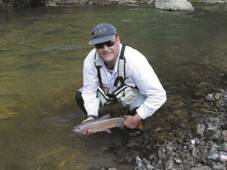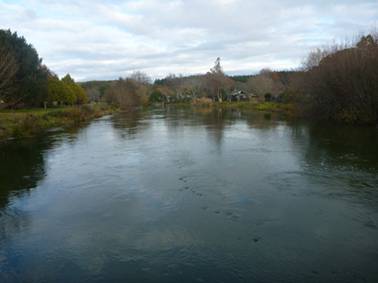ADAPTING

If you fly fish you are by your very nature adaptable. You may be a hide bound dry fly fisherman who refuses to try any other kind of fly fishing but you are still adaptable. Think about it, if you are fishing a pale watery dun and not catching fish you may try a Greenwell's Glory or even a Royal Wulff. You may change the length of your leader or the size of your tippet, you may even stop fishing and have a good look at what is hatching and adapt your fishing to the conditions and to the hatch.
If you are a nympher or a wet liner you will do pretty much the same things, changing fly, line sink rates or leader length until you strike the winning combination for today or maybe just for the next 10 minutes!
So why is it that most of us will not change the way we fish on most days? I know I have had days when I have stuck to one method even when it is not working; I have changed nymphs, tried smaller, bigger, brighter, heavier or lighter or just a change of colour. All to no avail, the fish just have not wanted what I have chosen to give them. On some rare occasions I have changed from a nymph to a dry when I can see fish rising, but rarely have I changed from a dry to a nymph or from a floating line to a sinker. I am sure most of the guys I have fished with are the same, we change the fly or lengthen the leader and think we are being adaptable, maybe it is time for some real adaptability?
The Spey casting I have started in the last year or so has opened my eyes to the fact that when you totally change your approach you tend to catch more fish.

As an example I am trying to learn to cast both Skagit and Scandi style with my switch rod. The Skagit line is perfect for fishing big streamers and getting them to the right depth by varying the length or sink rate of the tip. It is best used with sustained anchor casts like the double spey and the snap T. The Scandi line is more suited to long casts using touch and go anchors like the single spey or snake roll and is ideally suited to long leaders and nymphs or dry fly. So I will start fishing a pool with the Scandi line set up for nymphing, fish my way from the tail to the head and in most large pools this will involve at least 2 or 3 changes of nymphs and or leader set ups. Once I reach the head of the pool I will change to the Skagit head with a sinking tip of T12 or T14 depending on the depth and current speed and work my way back down the pool with a streamer, again on a large pool this may involve 2 or 3 changes of fly or leader to suit the changing depth and speed of each part of the pool. It is amazing how many times I have landed maybe one or two fish on the nymph and then taken another couple on the streamer on the way back down. These of course are fish I would not previously have touched as in the past I would get to the head of the pool and carry on up to the next pool.
Summer is coming here in NZ and this year I am going to try to do the same thing on some of my summer rivers, I may start with a nymph under a dry, fish carefully upstream and then take the dry off and put on a couple of wee wets for the return trip. I may even try a big wet fly dead-drifted on a floating line; anything different has a chance of being tried. If I get to a boulder filled run suited to short-line nymphing I may try it in the same style but with a big wet fly instead of a nymph, and horror of horrors if I find some rising fish I may not cover them with a dry, I may just chuck a Glo bug at them!
If you are happy fishing the same way each time you go out or you just can't bring yourself to tie on a big gaudy streamer instead of a small dainty dry fly then as they say here in NZ "Fill your boots" (This translates roughly as "go for it") but if you have a hard day and really want a fish why not try something out of the ordinary, it may just pay off.
If you really want to know if something may possibly work try it out on a good day, when the fish are biting and you are catching plenty. After all if you only try something when things are hard you are stacking the odds against it being successful. If you can bring yourself to change the deadly fly of the day and throw something different while the fish are biting you will know for sure if that change works or not, at least at that time and place.
When you think about it, how often have you matched the hatch and done everything "right" only to fail to catch any fish? I remember fishing the Tongariro about 16 years ago with a guy who had never fished before, we set him up with the right length of leader and good heavy nymph with a small unweighted one behind it and off we went. He caught nothing, but nor was anyone else catching, it was just one of those days. In the afternoon we fished the lower bridge pool and he got a large tangle in his leader, so rather than work his way up to us to sort it out for him he just changed to a sinking line, cut the tangle off and retied what was left to the end. He was now fishing a small size 16 champaign glow bug on a five foot leader and casting downstream. Just as one of the resident old farts walked up to tell him he was doing it all wrong he hooked up to a lovely fresh run rainbow of about 6 lb. I wonder if he had known he was doing it all wrong if he would still have tried that?
Anyway, next time I find myself fish-less on what should be good day I may just try doing it all wrong, after all if it doesn't work I will be no worse off.
All the best:
Mike
